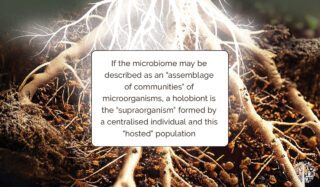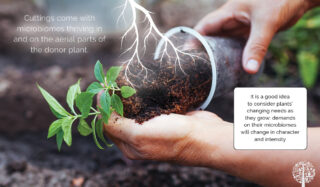Harvesting Holobionts: Cultivating Healthy Bodies
We hear many references to the “gut microbiome” lately. Thanks in large part to the work of fermentation enthusiasts, there has been a cultural turn toward cultivating healthy “microherds” of beneficial organisms within our bodies. Without necessarily realizing it, we’ve fundamentally changed our perception of ourselves as animal creatures. Modern scientific methods and technologies confirm and reveal the interconnectedness, even inextricability, of each of us with other species in our physical space.

We are constantly exposed to an immeasurable diversity of microbial life. Studies weave knowledge about mental and emotional wellness, neurological function, stress tolerance, and nervous system regulation with examinations of bacteria and yeasts inside and on our bodies (1). We are becoming more aware of the human-as-holobiont.
Greater than the sum of its parts: what is a holobiont?
If the microbiome may be described as an “assemblage of communities” of microorganisms (2), a holobiont is the “supraorganism” formed by a centralized individual and this “hosted” population.

The choice of “who gets in” isn’t always within control, as in the case of viruses against which no previously developed immunity exists. However, with intention, we can work toward providing a supportive microbiome, creating the conditions for swift, well-resourced, and decisive responses.
Coevolution through natural selection has guided the development of plant genetics that reach new heights of yield and environmental resilience when allowed to play with their full deck. This transformative perspective will enable us to conceptualize our cultivated plants as holobionts.
Why view plants as holobionts instead of individuals of a single species in a community with other organisms?
Only in the most strictly managed laboratory setting (reserved for propagation by tissue culture) is it desirable to pursue conditions approaching sterility.
Yet, we are rightly concerned about the advantageous growth of soil fungi that negatively impact young plant material, causing damp-off. We worry about transmitting viruses and other pathogens, especially those which have thrived and proliferated in our growing spaces.
Maintaining a clean growing environment, observing closely, and responding to issues with interventions or procedure changes is good practice. While this does work, it can lead to treating symptoms, not causes.
When we envision each plant as a holobiont, we acknowledge that while the general functions of the immune system and metabolism are encoded in the DNA of the plant, the effectiveness and health of those systems are highly reliant on microorganisms, some of which have coevolved and are highly specialized to the plant.
Incredibly, even in sanitized substrates and when controlled for exposure by air currents and through fertigation, the microbiomes of young plants can be rich with life. The seeds introduce diverse bacteria and fungi to the microbiome (3). These species are ‘vertically’ transmitted, from generation to generation, instead of being obtained ‘horizontally’ through the external environment. Vertically transmitted microbes are often among the most beneficial.

Seedlings and newly struck cuttings are busy establishing their root systems and leaves to acquire nutrition, gain energy and develop structures needed to be buoyant in life’s coming waves. It can be helpful to encourage the horizontal transmission of known beneficial microbes after reducing the number of possible encounters with powerful antagonists.
Cuttings come with microbiomes thriving in and on the aerial parts of the donor plant. Depending on the assessed health of those mothers, it is a judgment call as to whether there is more reason to dip and strip these surface microbes to eliminate the transfer risk of spores and other potential threats to a plant without its vibrant root microbiome.
Economies of space and resources and regulatory guidelines shape decisions about optimizing and prioritizing the needs of targeted holobionts within an ecosystem. Certain products are disallowed as sprays within a certain pre-harvest period for consumer protection, and environmental health is considered when it comes to the allowable application of nutrients, other agricultural amendments, and pest-management products.
Thankfully, data-supported evidence is being accumulated to demonstrate the real value of attending to the health of plant microbiomes. Where possible, allowing a population of diverse holobionts to coexist (e.g., in succession gardening and intercropping) favors the meetings of mutually beneficial organisms. This, in turn, has demonstrable economic relevance.
Who can add known beneficials to their grow?
Just as live food cultures are easily found in grocery stores, like apple cider vinegar “with the mother”, microbial inoculants have become commonplace in garden centres and grow stores. Any grower who can purchase pre-made soil mixes or fertilizers may now experiment with products certified to contain measurable amounts of beneficial bacteria and fungi.
Following the producers’ instructions is essential. There is no reason to believe that “more is better”; the plants will select those with which they work best, and these will increase under favorable conditions.
It is a good idea to consider plants’ changing needs as they grow: demands on their microbiomes will change in character and intensity. Just like “veg” and “bloom” nutrient mixes, it is not uncommon to see products designed with those same general life stages in mind. Others may contain a mix of species that will be ‘assembled’ and proliferate on or within the plant according to its needs as it develops.
In commercial settings, it is handy (or necessary) to reference the list of well-researched, specially selected and bred beneficial bacteria and fungi in purchased products. Many have been certified for use in organic production.
How to work with plants as holobionts varies according to growing style
As the main diversity of species in a unique plant’s root microbiome is horizontally assembled in the soil, it is crucial to consider the traits of your chosen growing medium.
Living soil growers and regenerative land stewards are familiar with various ways to acquire, support, and multiply diverse populations of beneficial microbes, making them available to plants via their root zones.
Some of these include:
- Brewing Actively Aerated Compost Teas (AACTs),
- Collecting and propagating Indigenous Microorganisms (IMOs),
- Using no-till,’ chop and drop’,
- And intercropping (companion planting).
Soil specialists are building capacity in agricultural networks, and you can consult with one or take courses yourself to gain from this holistic school of thought.
In these growing systems, the plant holobionts are generally given as much opportunity as possible to select and assemble their constituent populations of bacteria and fungi. When a singular species dominates an agricultural space, as in the case of monocropping, especially where genetically identical plants are grown, the preferences of that particular holobiont type reduce microbial diversity in areas under its strong influence.
Controlled environment growers using soilless mediums must take a different approach to ensure the continued availability and population balance of certain microbial populations. Often, these growers may have several subtypes of a commercially important species (for example, cannabis) under cultivation, and these also demonstrate variance within their microbiomes. Research suggests this is guided by the genetic favoring of certain partner microbes for producing target phytochemicals (e.g., THC, CBD, terpenes)(4).
Once acquired, aspects of a holobiont found within plant structures, as opposed to on the surfaces, may be less impacted by the ebb and flow of water in a hydroponic system. Ensuring the cleanliness of fertigation infrastructure (drip systems, especially recirculating ones) requires balancing the regular use of antimicrobial agents (like hydrochlorous acid and hydrogen peroxide) with their effects on the holobiont’s wellness.

Re-populate beneficials for different plant life stage requirements at regular intervals. At transplant, and upon altering lighting schedules or nutrient regimens, it’s a good strategy to ‘top up’ the diversity of available microbes so the plant can accumulate more of what will best serve them at that time.
In an intensively managed system where there are no insects to crawl up from the dirt, hop from leaf to leaf, or buzz about to sample nectar, a good argument can be made for misting or fogging with microbiome-supporting solutions, especially where seeds are being produced for future plantings. Instructions for appropriately cleaning plant parts designated for consumption before storage and use will be part of this protocol.
Strike a balance between allowing beneficials to thrive and not completely excluding or eliminating exposure to challenges. Various stressors enable plants to produce immune responses to maximize the production of commercially-valued secondary metabolites. Some other phytochemicals (plant-serving molecules but helpful to humans) contribute to post-harvest storage capacity and nutritional value. Since energy is always being used to power these processes, consider supplementation a means to keep the plant from having to manufacture this energy itself and use it to maintain its microbiomes.
Forward Thinking
Crop monocultures becoming extremely vulnerable to a particular disease has been historically explained by their loss of ability to “fight off” a unique, unfamiliar attacker. Shifting perspective to these crop plants as holobionts, we can understand better how disease resistance can become a function not only of supporting the immunity of plants within their lifetimes but also considering the inheritance of beneficial microbes and their co-evolutionary relationship with the genetics of the socially valued species.
Advancements in DNA research technologies and revelations of how microbial interactions with individuals influence the expression of specific genes, are exposing even greater complexity. More than ever before, we can explore the downstream, heritable impacts of plant microbiome wellness on domesticated plant species. Revisioning crop plants as invaluable co-stewards of the land makes it possible for guided, intentional, and more harmonious co-existence with unseen populations.
References:
(1) ncbi.nlm.nih.gov/pmc/articles/PMC5581153/pdf/oncotarget-08-53829.pdf
(2) dx.doi.org/10.1016/j.mib.2017.07.001
(3) doi: 10.3389/fmicb.2021.737616
(4) doi: 10.3389/fmicb.2020.00491